Page 180 of 320
GCWR (Gross Combined Weight Rating)/Trailer Weights
EngineRear
axle
ratioMaximum
GCWR - lb.
(kg)Maximum
Loaded
Trailer Weight
- lb. (kg)Maximum
frontal area of
trailer - ft
2
(m2)
E-350 Regular Wagon (11/12 Passenger) (8700 GVWR)
6.8L 3.7315000
(6804)8500 (3856) 60 (5.52)
6.8L 4.1018500
(8391)10000 (4536) 60 (5.52)
E-350 Extended Wagon (11 Passenger) (9300 GVWR)
5.4L 3.7313000
(5897)6500 (2948) 60 (5.52)
5.4L 4.1013000
(5897)6500 (2948) 60 (5.52)
E-350 Extended Wagon (11 Passenger) (9500 GVWR)
6.8L 3.7315000
(6804)8300 (3765 ) 60 (5.52)
6.8L 4.1018500
(8391)10000 (4536) 60 (5.52)
E-350 Extended Wagon (14/15 Passenger) (9100 GVWR)
5.4L 3.7313000
(5897)6300 (2858) 60 (5.52)
5.4L 4.1013000
(5897)6300 (2858) 60 (5.52)
E-350 Extended Wagon (14/15 Passenger) (9300 GVWR)
6.8L 3.7315000
(6804)8100 (3674) 60 (5.52)
6.8L 4.1018500
(8391)10000 (4536) 60 (5.52)
2009 Econoline(eco)
Owners Guide, 2nd Printing
USA(fus)
Tires, Wheels and Loading
180
ProCarManuals.com
Page 181 of 320
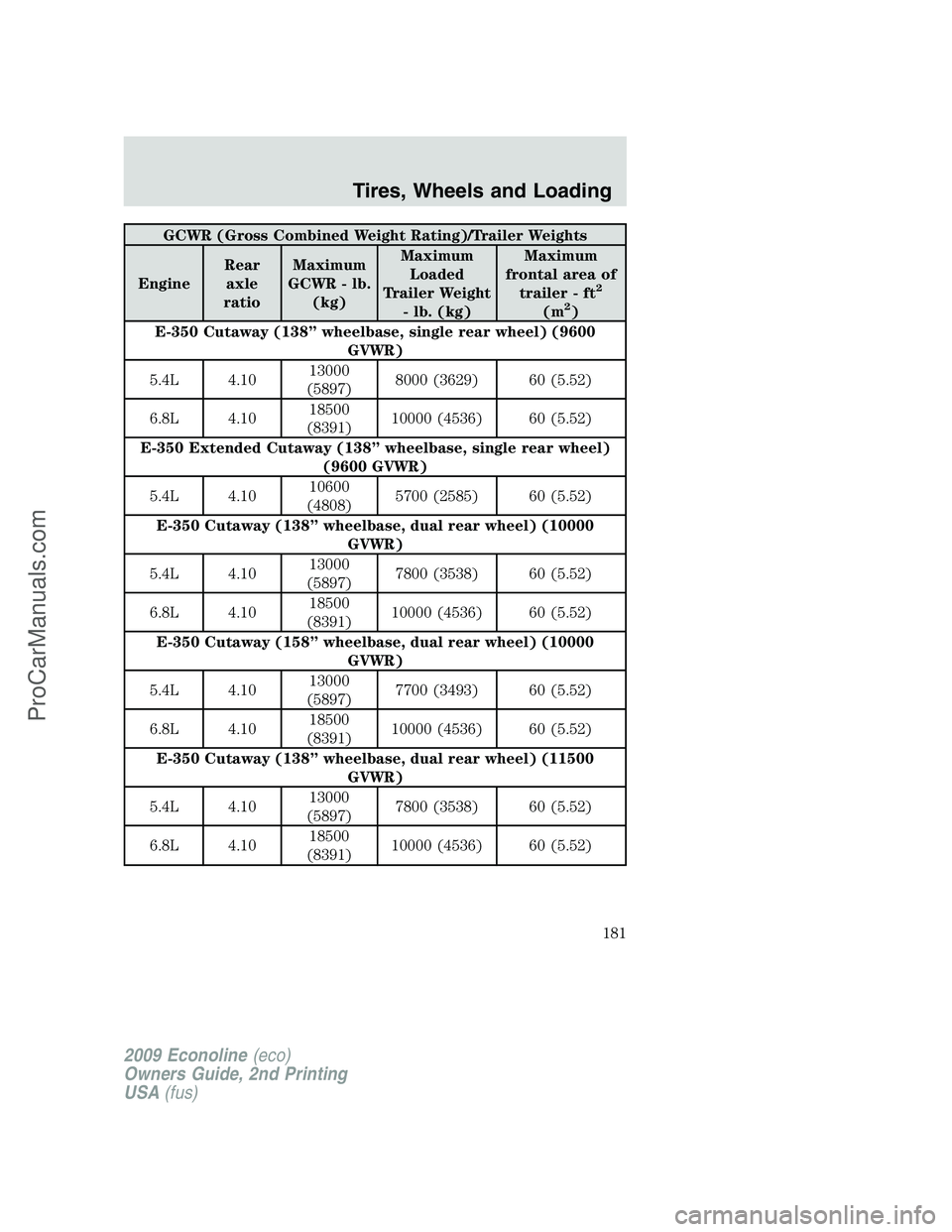
GCWR (Gross Combined Weight Rating)/Trailer Weights
EngineRear
axle
ratioMaximum
GCWR - lb.
(kg)Maximum
Loaded
Trailer Weight
- lb. (kg)Maximum
frontal area of
trailer - ft
2
(m2)
E-350 Cutaway (138” wheelbase, single rear wheel) (9600
GVWR)
5.4L 4.1013000
(5897)8000 (3629) 60 (5.52)
6.8L 4.1018500
(8391)10000 (4536) 60 (5.52)
E-350 Extended Cutaway (138” wheelbase, single rear wheel)
(9600 GVWR)
5.4L 4.1010600
(4808)5700 (2585) 60 (5.52)
E-350 Cutaway (138” wheelbase, dual rear wheel) (10000
GVWR)
5.4L 4.1013000
(5897)7800 (3538) 60 (5.52)
6.8L 4.1018500
(8391)10000 (4536) 60 (5.52)
E-350 Cutaway (158” wheelbase, dual rear wheel) (10000
GVWR)
5.4L 4.1013000
(5897)7700 (3493) 60 (5.52)
6.8L 4.1018500
(8391)10000 (4536) 60 (5.52)
E-350 Cutaway (138” wheelbase, dual rear wheel) (11500
GVWR)
5.4L 4.1013000
(5897)7800 (3538) 60 (5.52)
6.8L 4.1018500
(8391)10000 (4536) 60 (5.52)
2009 Econoline(eco)
Owners Guide, 2nd Printing
USA(fus)
Tires, Wheels and Loading
181
ProCarManuals.com
Page 182 of 320
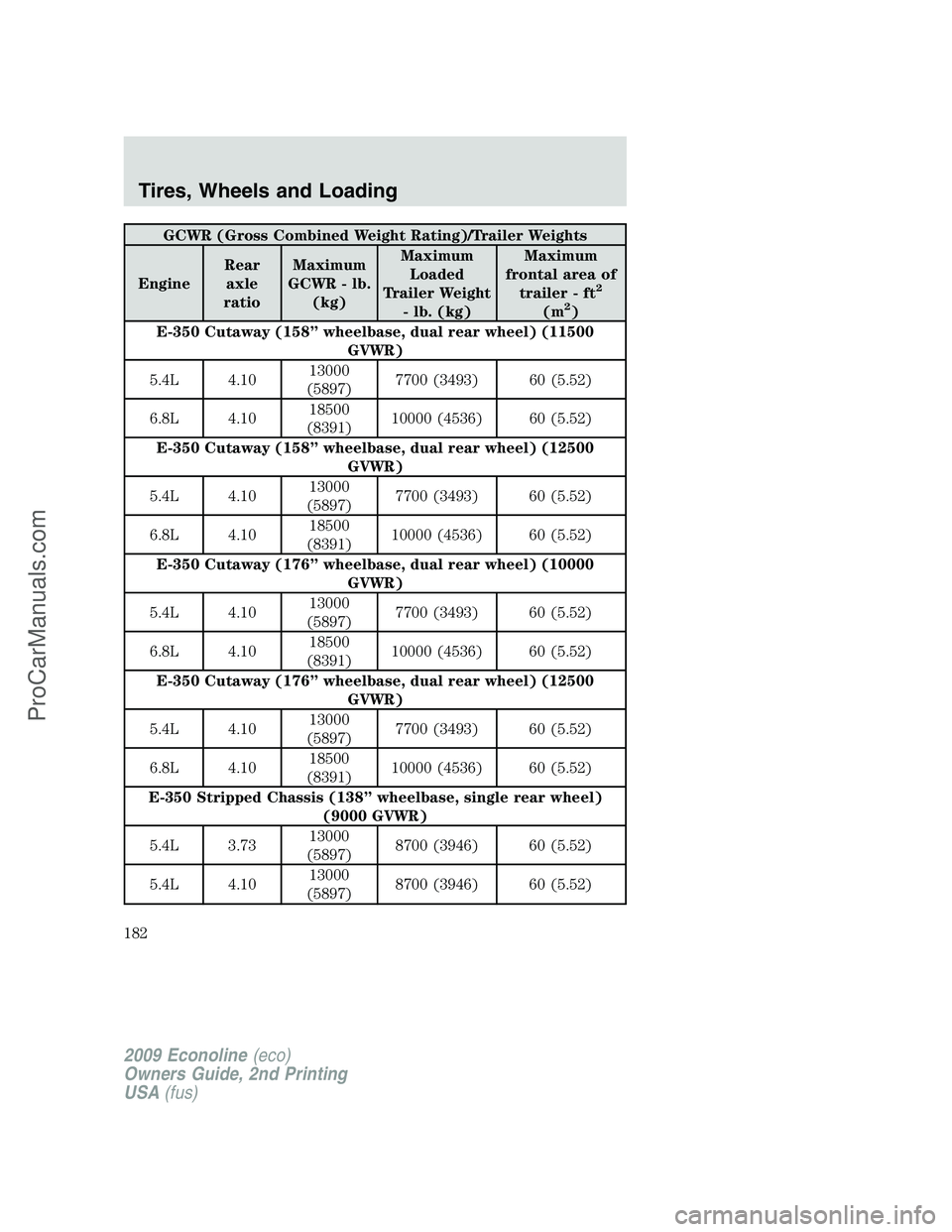
GCWR (Gross Combined Weight Rating)/Trailer Weights
EngineRear
axle
ratioMaximum
GCWR - lb.
(kg)Maximum
Loaded
Trailer Weight
- lb. (kg)Maximum
frontal area of
trailer - ft
2
(m2)
E-350 Cutaway (158” wheelbase, dual rear wheel) (11500
GVWR)
5.4L 4.1013000
(5897)7700 (3493) 60 (5.52)
6.8L 4.1018500
(8391)10000 (4536) 60 (5.52)
E-350 Cutaway (158” wheelbase, dual rear wheel) (12500
GVWR)
5.4L 4.1013000
(5897)7700 (3493) 60 (5.52)
6.8L 4.1018500
(8391)10000 (4536) 60 (5.52)
E-350 Cutaway (176” wheelbase, dual rear wheel) (10000
GVWR)
5.4L 4.1013000
(5897)7700 (3493) 60 (5.52)
6.8L 4.1018500
(8391)10000 (4536) 60 (5.52)
E-350 Cutaway (176” wheelbase, dual rear wheel) (12500
GVWR)
5.4L 4.1013000
(5897)7700 (3493) 60 (5.52)
6.8L 4.1018500
(8391)10000 (4536) 60 (5.52)
E-350 Stripped Chassis (138” wheelbase, single rear wheel)
(9000 GVWR)
5.4L 3.7313000
(5897)8700 (3946) 60 (5.52)
5.4L 4.1013000
(5897)8700 (3946) 60 (5.52)
2009 Econoline(eco)
Owners Guide, 2nd Printing
USA(fus)
Tires, Wheels and Loading
182
ProCarManuals.com
Page 183 of 320
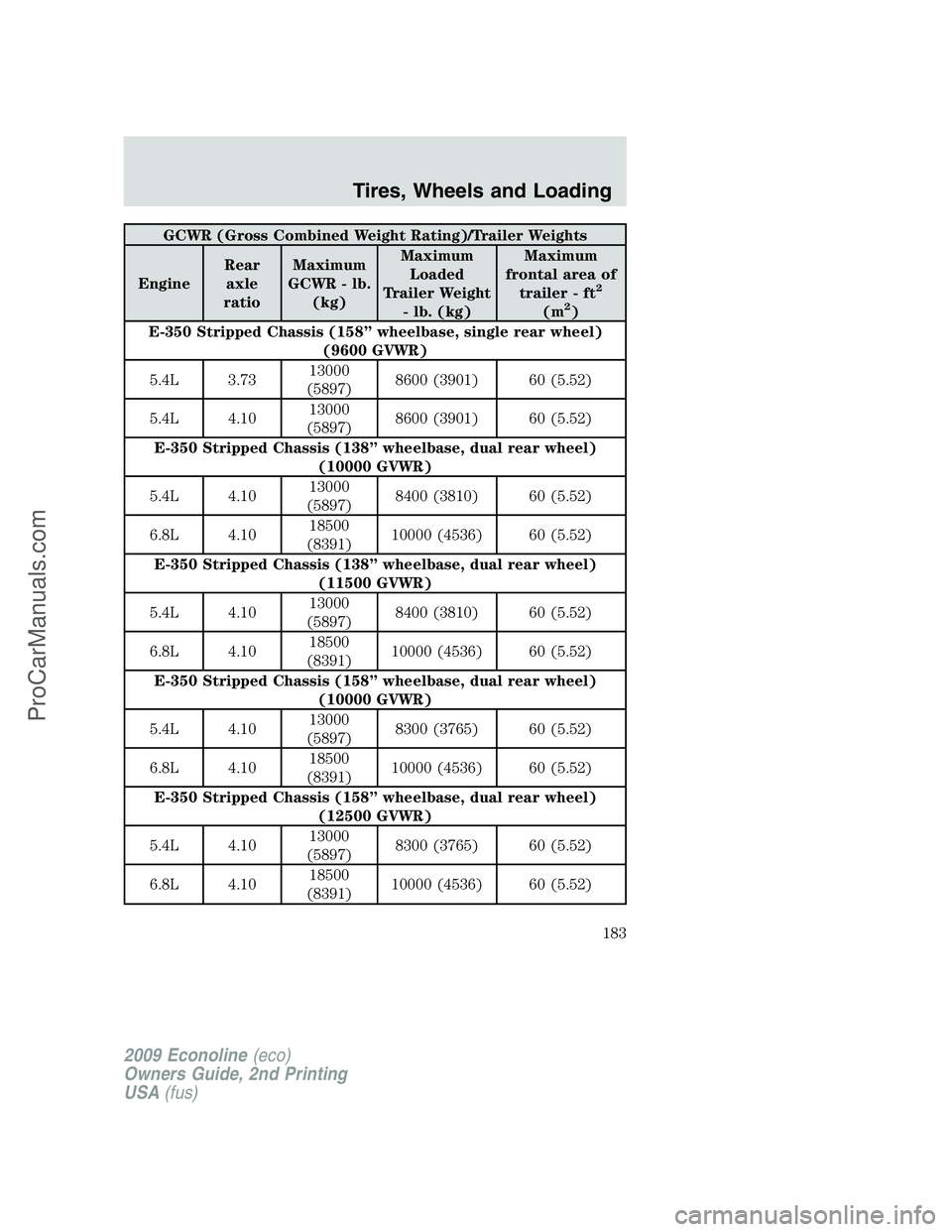
GCWR (Gross Combined Weight Rating)/Trailer Weights
EngineRear
axle
ratioMaximum
GCWR - lb.
(kg)Maximum
Loaded
Trailer Weight
- lb. (kg)Maximum
frontal area of
trailer - ft
2
(m2)
E-350 Stripped Chassis (158” wheelbase, single rear wheel)
(9600 GVWR)
5.4L 3.7313000
(5897)8600 (3901) 60 (5.52)
5.4L 4.1013000
(5897)8600 (3901) 60 (5.52)
E-350 Stripped Chassis (138” wheelbase, dual rear wheel)
(10000 GVWR)
5.4L 4.1013000
(5897)8400 (3810) 60 (5.52)
6.8L 4.1018500
(8391)10000 (4536) 60 (5.52)
E-350 Stripped Chassis (138” wheelbase, dual rear wheel)
(11500 GVWR)
5.4L 4.1013000
(5897)8400 (3810) 60 (5.52)
6.8L 4.1018500
(8391)10000 (4536) 60 (5.52)
E-350 Stripped Chassis (158” wheelbase, dual rear wheel)
(10000 GVWR)
5.4L 4.1013000
(5897)8300 (3765) 60 (5.52)
6.8L 4.1018500
(8391)10000 (4536) 60 (5.52)
E-350 Stripped Chassis (158” wheelbase, dual rear wheel)
(12500 GVWR)
5.4L 4.1013000
(5897)8300 (3765) 60 (5.52)
6.8L 4.1018500
(8391)10000 (4536) 60 (5.52)
2009 Econoline(eco)
Owners Guide, 2nd Printing
USA(fus)
Tires, Wheels and Loading
183
ProCarManuals.com
Page 184 of 320
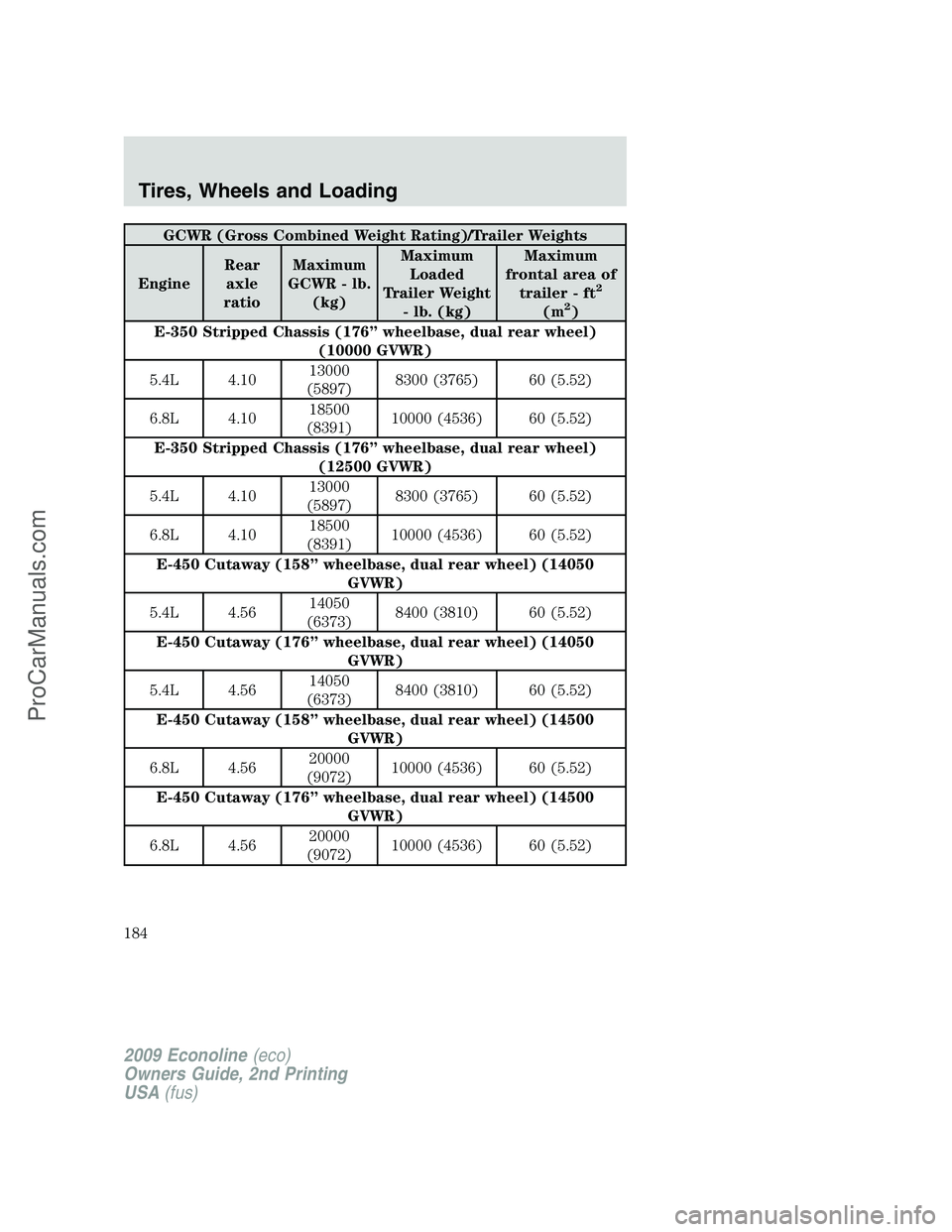
GCWR (Gross Combined Weight Rating)/Trailer Weights
EngineRear
axle
ratioMaximum
GCWR - lb.
(kg)Maximum
Loaded
Trailer Weight
- lb. (kg)Maximum
frontal area of
trailer - ft
2
(m2)
E-350 Stripped Chassis (176” wheelbase, dual rear wheel)
(10000 GVWR)
5.4L 4.1013000
(5897)8300 (3765) 60 (5.52)
6.8L 4.1018500
(8391)10000 (4536) 60 (5.52)
E-350 Stripped Chassis (176” wheelbase, dual rear wheel)
(12500 GVWR)
5.4L 4.1013000
(5897)8300 (3765) 60 (5.52)
6.8L 4.1018500
(8391)10000 (4536) 60 (5.52)
E-450 Cutaway (158” wheelbase, dual rear wheel) (14050
GVWR)
5.4L 4.5614050
(6373)8400 (3810) 60 (5.52)
E-450 Cutaway (176” wheelbase, dual rear wheel) (14050
GVWR)
5.4L 4.5614050
(6373)8400 (3810) 60 (5.52)
E-450 Cutaway (158” wheelbase, dual rear wheel) (14500
GVWR)
6.8L 4.5620000
(9072)10000 (4536) 60 (5.52)
E-450 Cutaway (176” wheelbase, dual rear wheel) (14500
GVWR)
6.8L 4.5620000
(9072)10000 (4536) 60 (5.52)
2009 Econoline(eco)
Owners Guide, 2nd Printing
USA(fus)
Tires, Wheels and Loading
184
ProCarManuals.com
Page 185 of 320
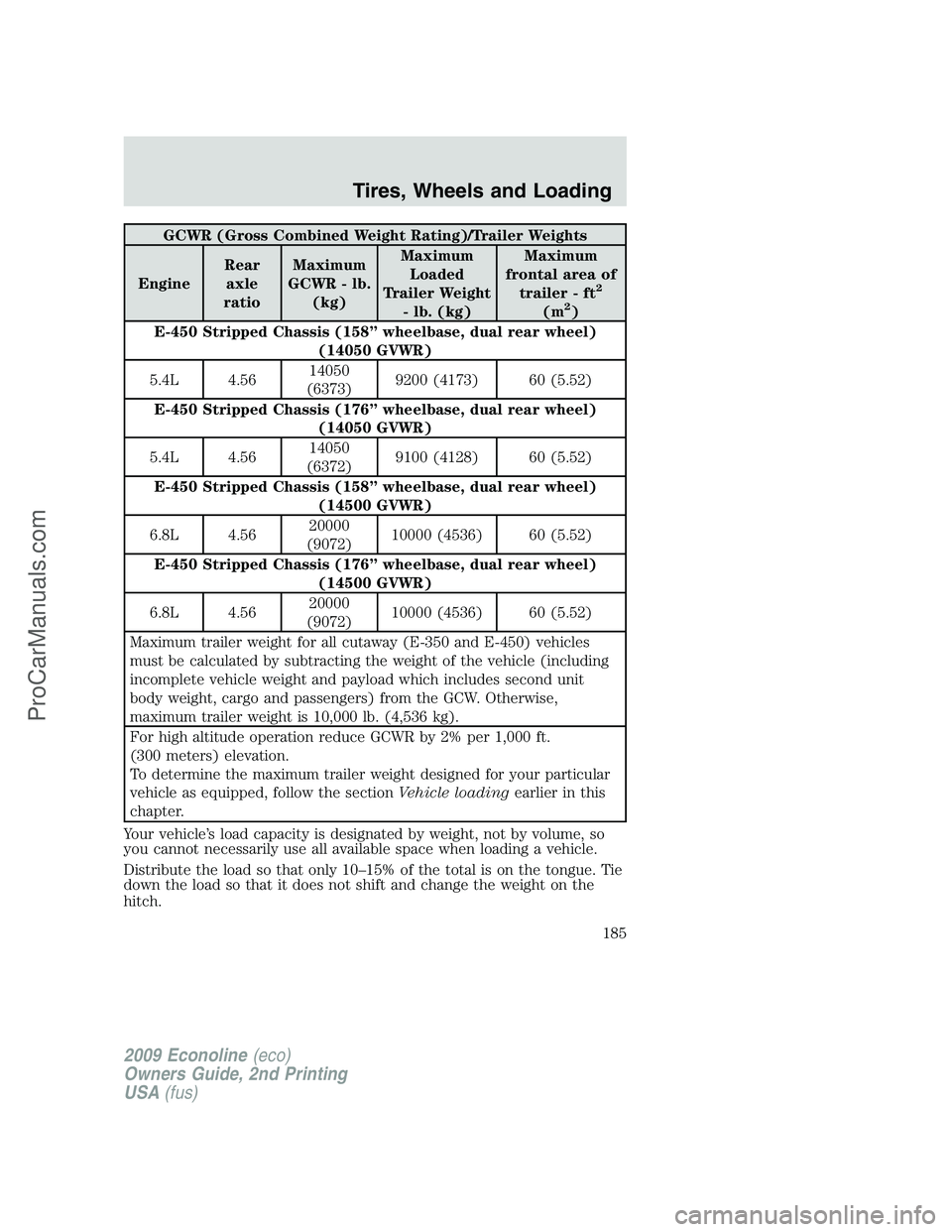
GCWR (Gross Combined Weight Rating)/Trailer Weights
EngineRear
axle
ratioMaximum
GCWR - lb.
(kg)Maximum
Loaded
Trailer Weight
- lb. (kg)Maximum
frontal area of
trailer - ft
2
(m2)
E-450 Stripped Chassis (158” wheelbase, dual rear wheel)
(14050 GVWR)
5.4L 4.5614050
(6373)9200 (4173) 60 (5.52)
E-450 Stripped Chassis (176” wheelbase, dual rear wheel)
(14050 GVWR)
5.4L 4.5614050
(6372)9100 (4128) 60 (5.52)
E-450 Stripped Chassis (158” wheelbase, dual rear wheel)
(14500 GVWR)
6.8L 4.5620000
(9072)10000 (4536) 60 (5.52)
E-450 Stripped Chassis (176” wheelbase, dual rear wheel)
(14500 GVWR)
6.8L 4.5620000
(9072)10000 (4536) 60 (5.52)
Maximum trailer weight for all cutaway (E-350 and E-450) vehicles
must be calculated by subtracting the weight of the vehicle (including
incomplete vehicle weight and payload which includes second unit
body weight, cargo and passengers) from the GCW. Otherwise,
maximum trailer weight is 10,000 lb. (4,536 kg).
For high altitude operation reduce GCWR by 2% per 1,000 ft.
(300 meters) elevation.
To determine the maximum trailer weight designed for your particular
vehicle as equipped, follow the sectionVehicle loadingearlier in this
chapter.
Your vehicle’s load capacity is designated by weight, not by volume, so
you cannot necessarily use all available space when loading a vehicle.
Distribute the load so that only 10–15% of the total is on the tongue. Tie
down the load so that it does not shift and change the weight on the
hitch.
2009 Econoline(eco)
Owners Guide, 2nd Printing
USA(fus)
Tires, Wheels and Loading
185
ProCarManuals.com
Page 186 of 320
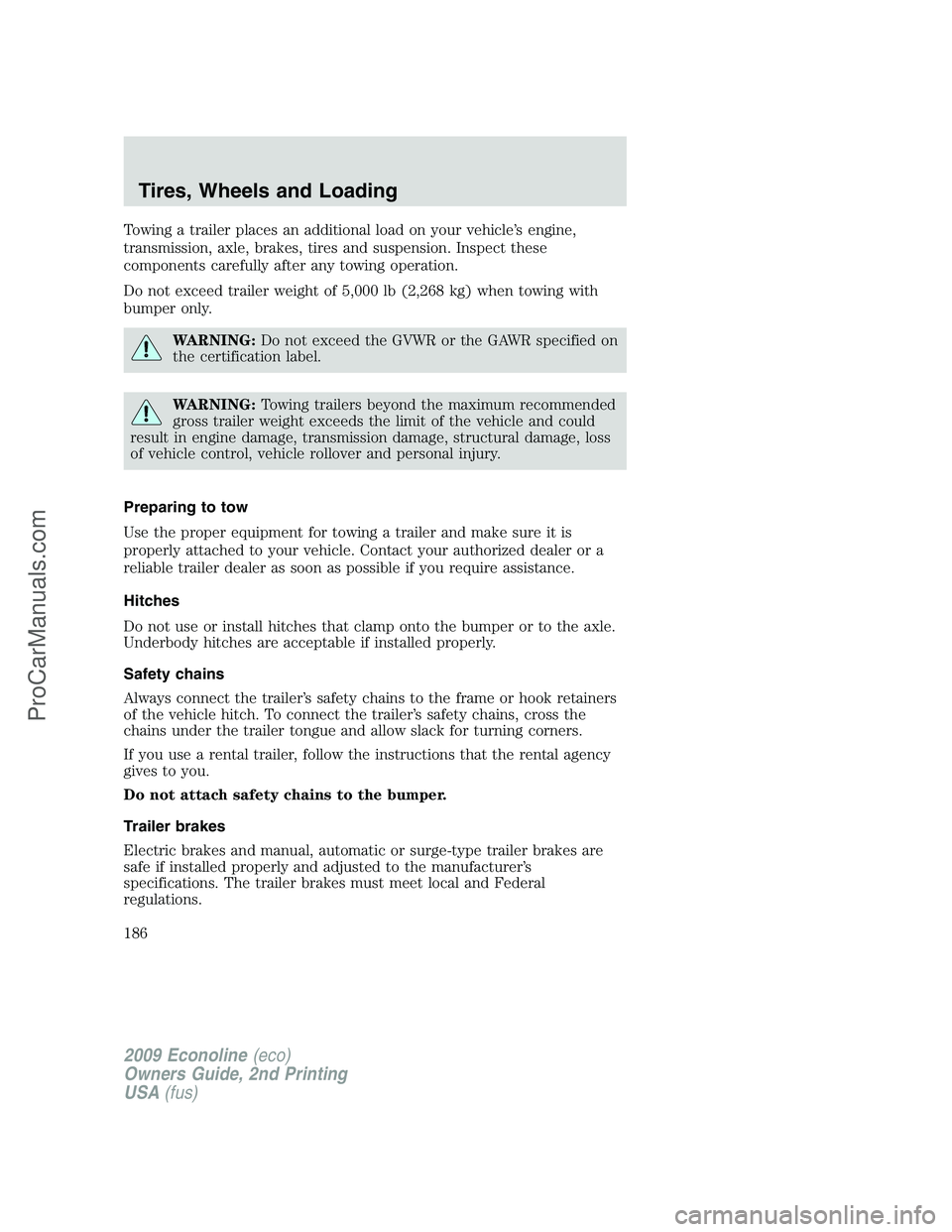
Towing a trailer places an additional load on your vehicle’s engine,
transmission, axle, brakes, tires and suspension. Inspect these
components carefully after any towing operation.
Do not exceed trailer weight of 5,000 lb (2,268 kg) when towing with
bumper only.
WARNING:Do not exceed the GVWR or the GAWR specified on
the certification label.
WARNING:Towing trailers beyond the maximum recommended
gross trailer weight exceeds the limit of the vehicle and could
result in engine damage, transmission damage, structural damage, loss
of vehicle control, vehicle rollover and personal injury.
Preparing to tow
Use the proper equipment for towing a trailer and make sure it is
properly attached to your vehicle. Contact your authorized dealer or a
reliable trailer dealer as soon as possible if you require assistance.
Hitches
Do not use or install hitches that clamp onto the bumper or to the axle.
Underbody hitches are acceptable if installed properly.
Safety chains
Always connect the trailer’s safety chains to the frame or hook retainers
of the vehicle hitch. To connect the trailer’s safety chains, cross the
chains under the trailer tongue and allow slack for turning corners.
If you use a rental trailer, follow the instructions that the rental agency
gives to you.
Do not attach safety chains to the bumper.
Trailer brakes
Electric brakes and manual, automatic or surge-type trailer brakes are
safe if installed properly and adjusted to the manufacturer’s
specifications. The trailer brakes must meet local and Federal
regulations.
2009 Econoline(eco)
Owners Guide, 2nd Printing
USA(fus)
Tires, Wheels and Loading
186
ProCarManuals.com
Page 191 of 320

Driving while you tow
When towing a trailer:
•To ensure proper “break-in” of powertrain components, do not trailer
tow during the first 1,000 miles (1,600 km) of a new vehicle.
•To ensure proper “break-in” of powertrain components during the first
500 miles (800 km) of trailer towing, drive no faster than 70 mph
(113 km/h) with no full throttle starts.
•Turn off the speed control. The speed control may shut off
automatically when you are towing on long, steep grades.
•Consult your local motor vehicle speed regulations for towing a trailer.
•To eliminate excessive shifting, use a lower gear. This will also assist
in transmission cooling.
•Anticipate stops and brake gradually.
When descending long, steep downhill grades, always use a lower gear to
provide engine braking to save wear on brakes. Use Drive (Overdrive
OFF) on moderately steep hills, Second (2) on steep hills, and First (1)
on very steep hills.Do not apply your brakes continuously, as they
may overheat and become less effective.
Servicing after towing
If you tow a trailer for long distances, your vehicle will require more
frequent service intervals. Refer to yourscheduled maintenance
informationfor more information.
Trailer towing tips
•Practice turning, stopping and backing up before starting on a trip to
get the feel of the vehicle trailer combination. When turning, make
wider turns so the trailer wheels will clear curbs and other obstacles.
•Allow more distance for stopping with a trailer attached.
•The trailer tongue weight should be 10–15% of the loaded trailer
weight.
•If you will be towing a trailer frequently in hot weather, hilly
conditions, at GCWR, or any combination of these factors, consider
refilling your rear axle with synthetic gear lube if not already so
equipped. Refer to theMaintenance and specificationschapter for
the lubricant specification. Remember that regardless of the rear axle
lube used, do not tow a trailer for the first 1,000 miles (1,600 km) of a
new vehicle, and that the first 500 miles (800 km) of towing be done
at no faster than 70 mph (113 km/h) with no full throttle starts.
2009 Econoline(eco)
Owners Guide, 2nd Printing
USA(fus)
Tires, Wheels and Loading
191
ProCarManuals.com